Catocala retecta
Catocala retecta
kah-TOCK-uh-lahmmreh-TEK-tuh
Grote, 1872
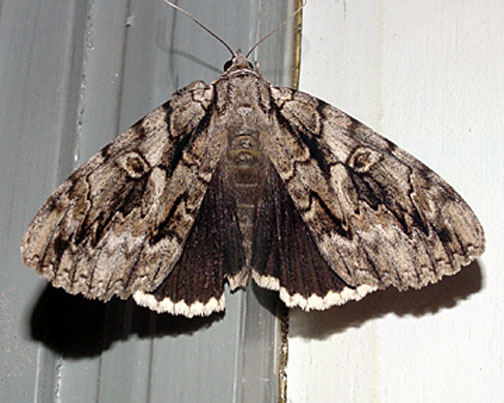
Catocala retecta, August 25, 2003, courtesy of
Tom Murray
copyright
This site has been created by
Bill Oehlke at oehlkew@islandtelecom.com
Comments, suggestions and/or additional information are welcomed by Bill.
| TAXONOMY:
Superfamily: Noctuoidea
Family: Noctuidae
Group: Noctuinina
Subfamily: Catocalinae
Genus: Catocala, Schrank, 1802
|
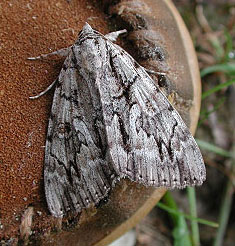 |
DISTRIBUTION:
It is also confirmed in
Connecticut,
Illinois,
Indiana,
Iowa,
Kentucky,
Maryland,
Massachusetts,
Michigan,
Mississippi,
Missouri,
New York,
North Carolina,
Ohio,
Oklahoma,
Pennsylvania,
Rhode Island,
South Carolina,
Virginia,
West Virginia.
John Himmelman took this picture, September 5, 2003, in
Connecticut.
He was surprised to find the moth on his shoe while checking the lights in the morning.
|
The light grey forewing is clearly marked with a basal dash that
continues with another dash through the antemedial line, followed by
another anal dash almost forming a bar parallel to the inner margin.
The hindwing fringe is white and is only lightly barred at the veins.
The "teeth" in the medial line are elongated and dark.
Catocala retecta courtesy of John Himmelman, Connecticut, September 5, 2003.
| 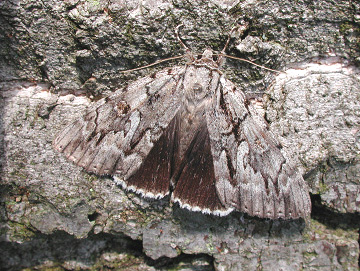 |
The black antemedian line is prominent and is inwardly lined with greyish white and then duplicated by a black line. A basal black dash runs from the body to
the center of the antemedian line, and then continues into the median area to the base of the open subreniform spot.
Note the light coloured, elongated and widely open subreniform spot which breaks the postmedian line. The center of the upper reniform spot is kidney-shaped and
brown, outlined in black, then grey, then black again.
The two upper teeth of the pm line are elongate and dark-tipped. Subsequent teeth are shorter yet still prominent and dark tipped. There is a large
wide tooth, underlined with a distinct black dash, below the interruption by the subreniform spot.
The subterminal area shows some brown scaling, becoming almost white as it meets the diffuse subterminal line. The terminal area is brownish-grey
with wing veins accentuated with black just below the apex. The vein running below the subreniform spot is also accentuated with black in the subterminal area.
The off-white (bright in fresh individuals) hindwing
fringe is only lightly checked along the wing veins.
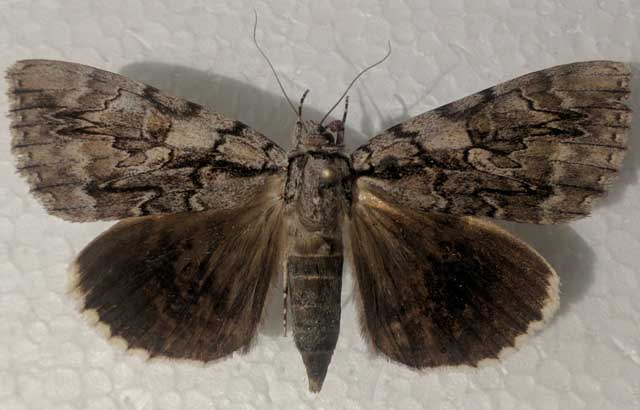
Catocala retecta, Quebec, courtesy of Randy Gage, id by Bill Oehlke.
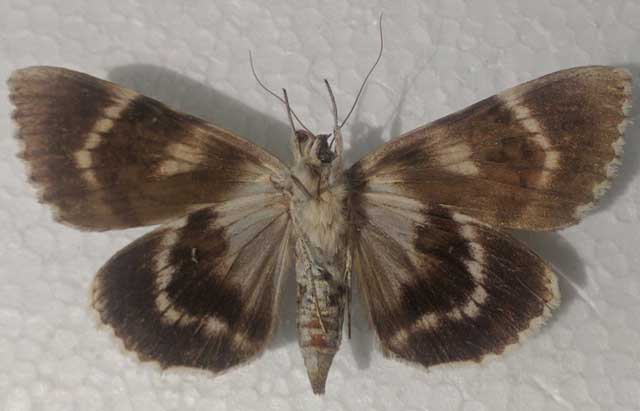
Catocala retecta (verso), Quebec, courtesy of Randy Gage, id by Bill Oehlke.
Visit wing descriptions.
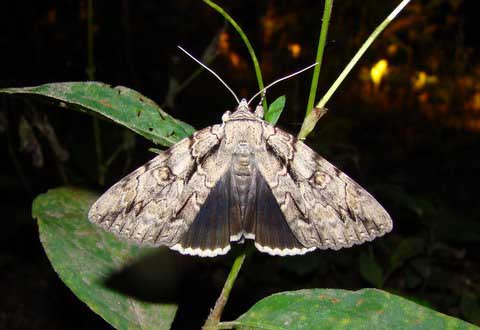
Catocala retecta, Windsor, Ontario, courtesy of Maurice Bottos.
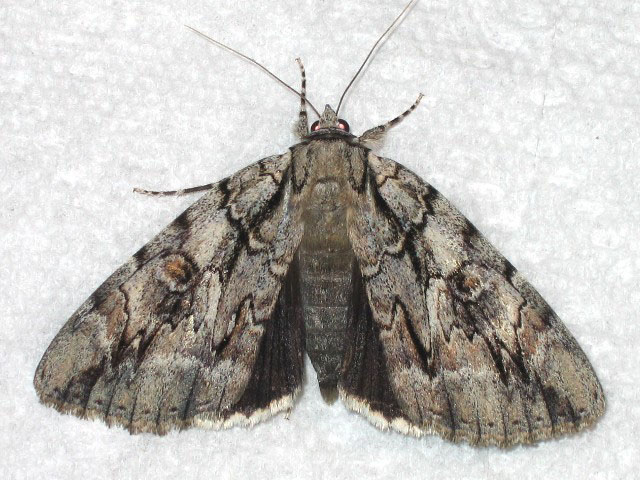
Catocala retecta, Stillwater Township, Sussex County,
New Jersey,
August 2, 2006, courtesy of Joe Garris.

Catocala retecta, lights, Woodlawn, Montgomery County,
Tennessee,
August 24, 2006, courtesy of Tom Payne.
Note the light coloured, elongated and open subreniform spot
which interrupts the dark, diffuse ark running through the center of
the wing from the basal area (body-wing juncture) to the forewing
apex. The center of the reniform spot is brown and there is a brown
area just below the costa running to the inner margin just outside the
pm line. The off-white (bright in fresh individuals) hindwing
fringe is only lightly checked along the wing veins.
Visit Catocala retecta, Londonderry, Rockingham County, New Hampshire, August 6, 2006,
courtesy of Deb Lievens.
Visit Catocala retecta, Pickens County, northern Georgia, August 23- September 17, 2009,
courtesy of Aubrey Scott.
Visit Catocala retecta, Dryden, Tompkins County, New York, August 27-28, 2013, courtesy of Tom Nix.
FLIGHT TIMES AND PREFERRED FOOD PLANTS:
Catocala retecta are on the wing from July to October. Peak flight is probably in August-September in the northern portions of range.
The Catocala retecta caterpillar feeds on Juglans and Carya species: pecan and hickories.
ECLOSION:
Adults eclose from pupae at soil surface.
SCENTING AND MATING:
Catocala retecta females
emit an airbourne pheromone and males use their antennae to track the
scent plume.
EGGS, CATERPILLARS, COCOONS AND PUPAE:
Eggs are deposited on
tree bark in the fall and hatch the following spring.
Ron Nelson, teamed with Gabriel Larrabee, sent me the image
below of Catocala retecta
eggs from Milwaukee.
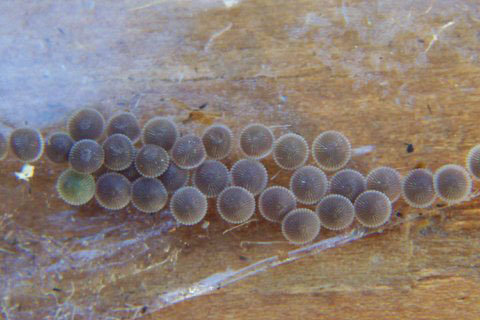
Larval Food Plants
Listed below are primary food plant(s) and alternate food plants.
It is hoped that this alphabetical listing followed by the common
name of the foodplant will prove useful. The list is not exhaustive,
although some species seem very host specific.
Experimenting with closely related foodplants is worthwhile.
Carya glabra
Carya illinoinensis.......
Carya ovata
juglans nigra
|
Pignut hickory
Pecan
Shagbark hickory
Black walnut
|
Use your browser "Back button to return to the previous page.
Goto Main Catocala Index
This page is brought to you by Bill Oehlke and the
WLSS. Pages are on space rented from Bizland. If you would like to become a "Patron of the Sphingidae/Catocala Sites",
contact Bill.
Please send sightings/images to Bill. I will do my best to respond to requests for identification help.
Enjoy one of nature's wonderments: Live Saturniidae (Giant Silkmoth) cocoons.

|

To show appreciation for this site, click on the flashing
butterfly to the left, a link to many worldwide insect sites. |
Return to Canadian Index
Return to Main Index










